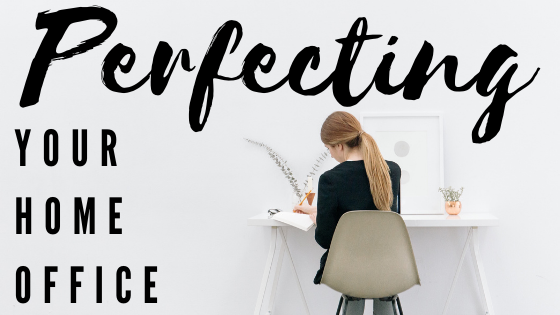Perhaps it is far past time for you to make your COVID-19 “quarantine-home-office” liveable. Perhaps you’re like me and are beginning your entrepreneurial journey and need a setup to match your new status as CEO. Or, perhaps you just need a little inspiration to help you level-up your existing workstation. Whatever your reasoning, we’re in this home-office life together. Scroll a little deeper with me and let’s take a look at how you can improve your workspace game!
What Makes an Ideal Workspace?
Deciding where to put your permanent or makeshift home office is the most important step. Ideally, you will have a whole room to dedicate to your workspace. Sometimes, however, you are not so fortunate. You may find yourself in the position that I did back at the start of COVID-19, where your dining room table in the middle of your living area is literally the only halfway-decent option available to you.
Whatever your space constraints, take care that your work area has the following:
- A reasonably uncluttered background.
- A good front-facing light-source. Avoid backlighting so that people can see your face during video conferences!
- Quiet (or at least the ability to make it quiet for the duration of your calls and conferences).
How Do I Choose a Desk Style?
When setting up your desk area, it is important to take your physical needs and environment into consideration. Can you sit for hours in essentially the same position without issue? Do you need physical movement to stay happy? Does it help your neck and back to stand while you work? Do you have the ability to work from various locations or are you confined to just one place?
Keep in mind that the right desk style for you could vary over time. Throughout different phases, I’ve had several different desk setups. My physical needs have remained the same (I really need the ability to move, change positions, and stretch often), but as my environment changed, my desk needs changed too.
Here are a few examples:
Kinetic Workstation

When I worked in corporate America, this hydraulic convertible desk paired with a Whirly balance board was my absolute favorite! The desk topper gave me the ability to easily switch between standing and sitting. The Whirly board gave my feet something to play with while sitting and a way to stretch my muscles while standing. Before I knew what my new house would be like, I had planned to duplicate this workstation at home.
Makeshift Standing Desk

When COVID-19 forced me to work from my tiny condo, I had no choice: it was the kitchen table or nothing. With little room to stretch in my 600-ish square-foot space, I had to get creative and build myself a standing desk to keep me sane. Thankfully my collection of vintage suitcases was perfect for the task!
Closeable Desk

Because my new house has a staircase and multiple spaces for me to walk and stretch, I discovered that a standing desk was no longer necessary for my wellbeing. But guess what? Now that I work 100% from home, I need a way to keep myself away from work when time’s up. Having a closeable desk was the perfect solution! Of course, the second monitor cannot close inside, but it isn’t hard to set in the closet to discourage over-working.
What Are Ergonomics?
Whenever I heard that word in the past, my mind almost exclusively went to those weird-looking ergonomic keyboards. But ergonomics are so much more than just that! Having an ergonomic workspace could be the difference between comfort and suffering severe neck aches. An ergonomic space will allow you to stay in your space longer and ultimately increase your productivity.
Here are four impactful things you can do to make your space more ergonomic and comfortable:
- Keep your monitor(s) at eye-level — This can be done by setting it on top of books, containers, or other flat, stackable surfaces. If you can sit looking straight-across at your screen(s) without tilting your head up or down, mission accomplished! This will help prevent neck aches.
- Use an external keyboard — If you use a laptop, it may be tempting to type on the attached keyboard, but don’t do it long-term! Laptop keyboards are great in a pinch, but for regular use at a desk, invest in an external keyboard. Then you can elevate your laptop screen to eye-level AND type in a comfortable position. You should aim to keep your elbows at an open angle, about 90 – 110 degrees.
- Choose a comfortable mouse solution — I personally recommend a gaming mouse, as they are intended to comfortably rest your hand on for an extended period of time. I have been using a Logitech G602 mouse for the past 4 years and have never felt any strain or discomfort. Other good options include trackballs, external trackpads, and pen tablets. Whatever you pick, choose an option that allows your hand to sit in a position that feels natural to you. Avoid getting something that feels too small or doesn’t allow your fingers to relax.
- Pick the right chair — The right cushion/seat size, back support, height, and arm options all come into play. Don’t just buy a chair online because the reviews seemed good. What may be a good chair for one person may not be a good chair for you; everyone is built differently! Even if it takes longer to find the right fit, I recommend that you buy your desk chair in person. You’ll be able to test your chair immediately, and buying in person will make returns simpler if you change your mind.
What is Your Next Step?
What is one way that you can work on improving your workspace this week? Whether it’s something simple like tidying the room or something bigger, like purchasing a chair, I’d love to hear about it! Drop a comment below to keep the conversation going.

Leave a Reply